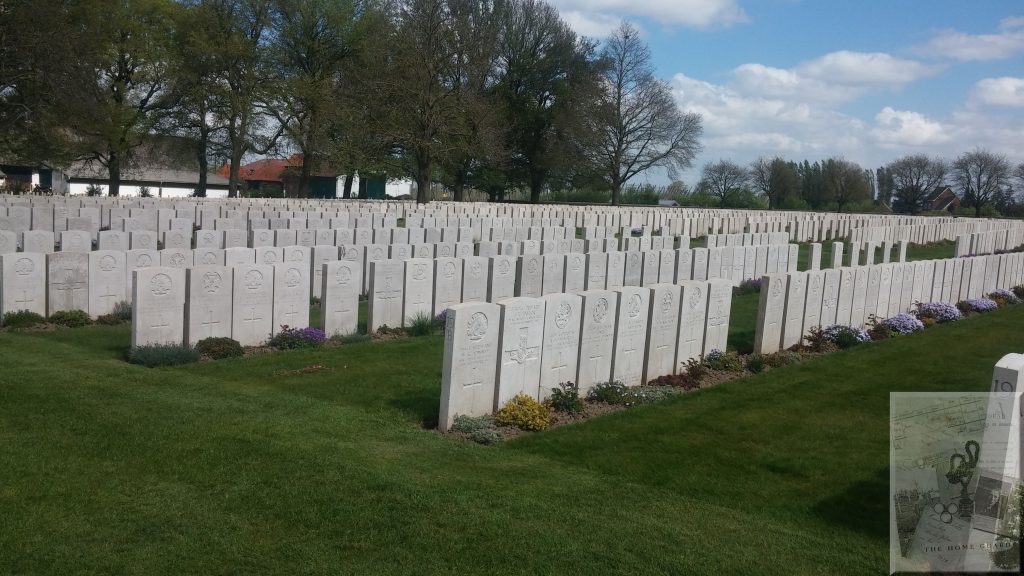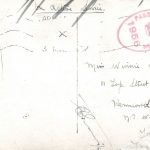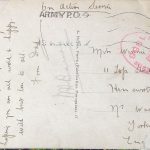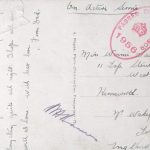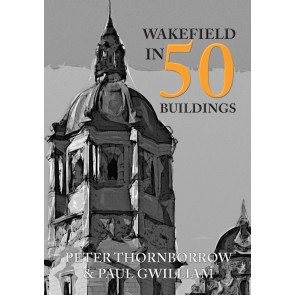Sayles Family Postcards – who are they?
At a recent meeting of local family history society, I was shown a set of three WW1 postcards. During the society notices the postcards were mentioned as they had a local connection – did anyone know the family or the surname? No one came forward. In the likely hood that no one came forward I had already I volunteered myself the task of finding who the people were – the sender and the recipient.
Each of the hand coloured postcards portrayed pretty young girls in various seated poses, each one held or had a posy of flowers. The 100-year-old cards were nice but what was written on the back was even more interesting, well it was to me.
After leaving the cards alone for a few days I sat down with them and with a couple of minutes I had the family in 1911. A few minutes later I had the service and pension records of the father of the family.
Who were these people found in records over 100 years later? They were Winnie Sayles and her father Ernest who sent the cards to his daughter while he was in France during March of 1917.
Ernest had been born in 1885 in Kirk Smeaton, Yorkshire, the son of William and Annie. In 1891 the family were living at Cistern Cottage, Hemsworth, where William aged 28 worked as a railway platelayer. Ten years later, their home was now on Sand Hill Terrace, Hemsworth where a young Ernest was a chemists’ apprentice.
In the winter of 1906, Ernest married a young lady named Sarah Briggs and the following year their daughter Winnie was born. A few years later the family were living with Ernest’s parents and a lodger, William Wilson, at 11 Top Street, Hemsworth, the address to where the postcards were sent and my initial find with the 1911 census. Ernest was now working as a cycle repairer, probably as an agent for a larger company.
The years passed and on the 11th of August 1916, Ernest, now aged 31and a mechanic and dealer Attested to the ASC (Army Service Corps) and became Private, M2/201741. He did seem to be a bit picky on where he served as question 9 Are you willing to be enlisted for General Service? Ernest answered Yes, with Motor and Mechanical Transport. Not sure if that went down too well with the recruiting officer as after Yes, has been struck through. There are only three pages of Ernest’s service record but they do give quite a bit of information.
Firstly, information as to his address of 55 Doncaster Road, Goldthorpe, Rotherham. His wife is named along with her maiden name and the date of their wedding – 21st November 1906 in Hemsworth Catholic Church, Next are his children and their place and dates of birth – Winnifred Annie, 31st October 1907; Agnes, 23rd June 1911 and William Edward 13th October 1914.
When Ernest wet to France in September 1916, life carried on for his family. Ernest was in the Motor Transport Depot, Calais and it seems possible that the three postcards to his daughter Winnie were sent from thereabouts
The postcards are dated, even though the date stamp is very faint, between the 3rd of March and the 18th of March. The day following his last postcard Ernest is reclassified as a Technical Storekeeper and on the 11th of January the following year Ernest is ‘Discharged, No longer physically fit for war service para 392 (XVI) KR.
Following Ernest’s discharge, curiosity leads me to wonder why and thankfully there are pension records surviving that can answer that question. There are 13 pages of these records and they include much of the information a service record would, however, this set of records contain much more. They are not in date order so I will go through page by page and pass on information about the father of our family.
The Pension Record Card for Ernest gives a name; date of birth; rank, regiment and service number – which is expected; date of examination; details along with invaliding disability and degree of disablement plus a short medical report. All very interesting headings but the information contained under those headings answers some questions. Ernest was medically examined and was given the diagnosis of Dilation of Myocardium in December 1916 and given a 20% disability. He had been also examined in France – Dyphoera (?) and Palpitations. The card continues with examinations taking place in Sheffield, Barnsley and Wakefield. Ernest complained of shortness of breath, sleeplessness but overall was well nourished. Although the medical examiners writing is quite technical there are some words that can be understood, including – intermittent and irregular sounds, becoming very faint, ‘has a large hypertrophied heart and definite aortic sclerosis’ when talking about Ernest’s heart.
As I’ve already said Ernest’s medical history started in France in December 1916 which was noted in a Medical Board Examination in December 1917 wrote ‘Not the result of but aggravated by military service, overstrain and hard work. Impossible to state if permanent.’ Ernest’s time in France lasted less than 12 months (6 September 1916 to 31 May 1917), having served at home from 9 Aug 1916 to 5 September 1916.
Ernest was discharged from Woolwich Dockyard on the 11th of January 1918 aged 33 years and 6 months old. Whoever completed the form included the wrong age for him and it was struck through. He was 5′ 8” tall and a fully expanded chest of 35½”. He had a fair complexion, grey eyes, light brown hair and had three moles on his back and had a good character.
The Medical History for our soldier seems to have made him shrink ½”. Added details include that he weighed 125lbs and the moles were between his shoulder blades. He also had two vaccination marks. This document also includes Ernest’s birth parish – Kirk Smeaton.
Although these Pension papers are not in any order and while writing I feel his life is a little disjointed I do hope that the information is of interest. One more printed sheet tells that in May to July of 1917 he was in Tooting Military his with abscess of lids – Patient was admitted with boils on neck which resulted in complications. As we already know, Ernest left France in May of 1917 – the day he was admitted to Tooting Military Hospital, which was were, after his medical complications, his heart problems were discovered.
And it was that Ernest left the army with a Conditional disability and was given a 24/- pension plus 14/1 for two children – what had happened to the third child he had previously been given a small pension for? His degree of disability going from 20% to 60% in 1922.
An SWB (Silver War Badge) number 315,128 had been issued to Ernest when he had been discharged due to sickness (KR 392 (xvi) 2 (b) I). This document gave his date of enlistment as 12 December 1915, which contradicts his date of Attesting in August 1916.
Did Ernest and Sarah live long enough to be recorded in the 1939 Register? Yes, they did! 6 Parkhill Avenue, in the Dearne Urban District was where the family called home. Ernest confirmed by his date of birth, 29th June 1884 was a Public Assistance Clerk; Sarah, born on the 22nd November 1882 was UDD (Unpaid domestic Duties) and William Ed. Born on 13th October 1914 was the only other visible entry – the other three being officially closed.
Winnie, the recipient of the postcards married Edward Gray in early 1940 in the Doncaster Registration District.
Sarah, Ernest’s wife died on the 14th of January 1955, a day that has special significance for my family. Don’t you find that in family history there are many coincidences, some stranger than others?
Ernest died in 1967.
Does anyone know this family?
Like this:
Like Loading...
